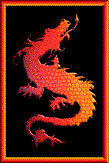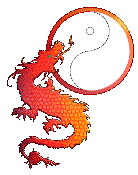
| The Chakras | ||||||
 |
Chakra (pronounced CHAK'-krah or SHAH'-krah) is a Sanskrit word meaning "wheel".
Traditionally, there are seven primary chakras located along the spine, which are energy centers of the etheric body.
The chakras appear to some people as vortices of colored light, and are sometimes represented or referred to as "lotuses".
Each chakra has its own purpose, associations, and connections; each chakra has a unique vibratory rate, or frequency,
which gives it a distinct color and resonant musical tone. The chakra energy is thought to spin— clockwise for males; counterclockwise for females— manifesting the spinning shape of a funnel spiraling inward in a "torando" effect. Each chakra spins at a different rate.
Each chakra corresponds to major acupuncture points in the Traditional Chinese Medicine system. In the practice of QiGong, it is thought that practicing Phonation, that is, manifesting the healing tones associated with each chakra, during QiGong practice will harmonize chi (qi) and have a positive effect on overall health. |
|||||







 |
||||||
|
|
||||||
 |
7. The Crown: Sahasrara |
|
This chakra is the seat of our cosmic consciousness and spiritual wisdom. It is the final transformation of our cosmic energy drawn up from the Root. It is the place where we must surrender all that we believe and all that we have become to that which is greater than ourselves. It is the place of transcendence.
The thousand petal lotus. In meditation, its color is violet, white, or gold; its resonant note is B; its mantra is "aum" or "eee" (as in "bee"). It transcends all the senses. |
|
|
|
|
 |
6. The Brow: Ajna |
|
This chakra is the seat of intuition, awareness, insight, and phychic perception, hence it is also known as "the third eye." It strives towards the spiritual, reconciling our drives, feelings, and thoughts with dharma. It is the bridge between the physical and the spiritual. It speaks to us in dreams.
The ninety-six petal lotus. In meditation, its color is indigo; its resonant note is A; its mantra is "shahm" or "mmm." It is associated with the "sixth sense." |
|
 |
5. The Throat: Vishuddha |
|
This is the chakra of Creative Expression and Communication. It is the beginning source of intuition. It allows us to transform emotions and feelings into ideas, words, and Art. It expresses the truth of the Heart.
The sixteen petal lotus. In meditation, its color is cyan blue; its resonant note is G; its mantra is "hahm." It is associated with the sense of hearing. |
|
 |
4. The Heart: Anahatha |
|
This chakra mediates between the lower physical planes and the higher mental planes; it is the gate between. It balances and stabilizes our life force. It gives us our ability to love and to be compassionate, to give and to receive freely.
The twelve petal lotus. In meditation, its color is green (and sometimes pink); its resonant note is F; its mantra is "yahm" or "aaa" (as in "ah"). It is associated with the sense of touch. |
|
|
|
|
 |
3. The Solar Plexus: Manipura |
|
This chakra is the source of both laughter and tears. It is the seat of our "gut feelings." It is our physical sense of knowing. Here we "know" our opinions, store our emotional baggage. Here we find the strength to stand up for what we believe.
The ten petal lotus. In meditation, its color is yellow; its resonant note is E; its mantra is "rahm" or "aum." It is associated with the sense of sight. |
|
|
|
|
 |
2. The Sacrum: Svadishtana |
|
This chakra, located at the top of the sacrum, is the center of physical energy and pure emotion. It is the source of all our basic physical drives and unintellectualized emotional needs, our "animal instincts." It is where healing begins.
The six petal lotus. In meditation, its color is orange; its resonant note is D; its mantra is "vahm" or "ooo" (as in "home"). It is associated with the sense of taste. |
|
|
|
|
 |
1. The Root: Muladhara |
|
This chakra, located at the very base of the sacrum, is that through which we draw the pure force of the universe. It grounds us in the universe, like the root of a plant, allowing us to draw the nourishment we need to live and grow. It is the beginning place, the place of birth and rebirth. The Kundalini.
The four petal lotus. In meditation, its color is red; its resonant note is C; its mantra is "lam" or "eee" (as in "fed"). It is associated with the sense of smell. |
|
|
|
|
 |
Phonation: Engaging the Chakras |
|
To engage a chakra, begin by inhaling and exhaling gently and evenly through the nose, keeping the mouth closed. At the beginning of the fourth exhalation, initiate the chakra sound on the chakra note as one continuous, smooth, relaxed nasal humming sound. Do not force the sound. The sound should arise from the dantien and have the dantien's power behind it, supporting it. As you hum the sound, feel the sound vibrate through your being, becoming warm. Simultaneously envision the color associated with the chakra. When you come to the end of your breath, end the sound gently, but firmly. The phonation may be practiced singly, or as a mantra, over and over. When you are done with each chakra, place your hands, one upon the other, over your dantien. Circle your hands around the dantien slowly three times clockwise, and three times counterclockwise, then press the dantien with your fingertips. Emit the chakra sound vigorously once.
Note: Advanced students of QiGong are encouraged to practice phonation in conjuncton with the "small circle" and "big circle" exercises for moving the the chi (qi) around the Conception and Governing meridians.
|
|
|
|
![]()
Please report problems and link errors to:
Thanks!